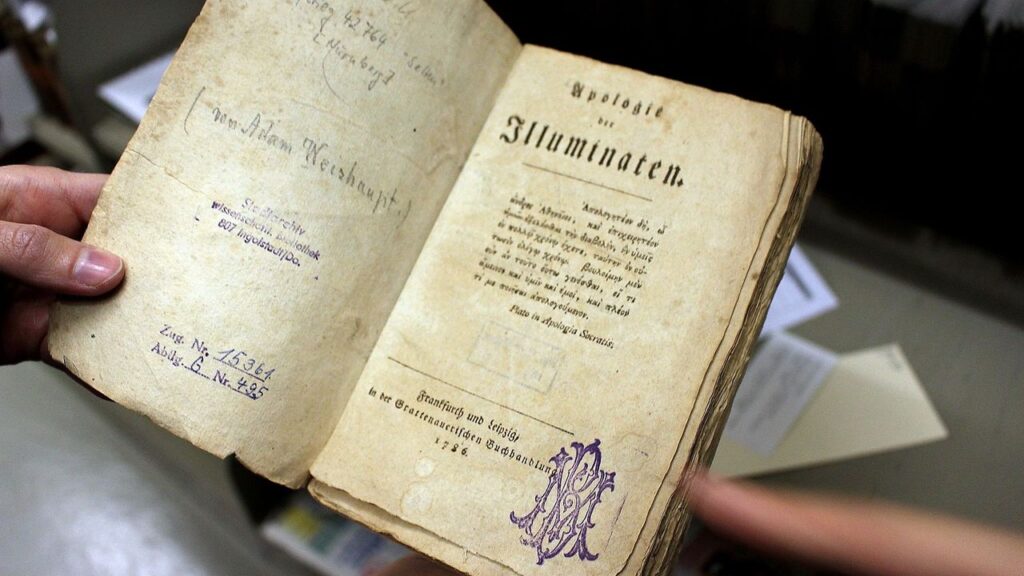
The enigmatic and secretive nature of the Illuminati has made it a fascinating subject for authors and filmmakers. This shadowy organization, rumored to manipulate global events from behind the scenes, has been depicted in various ways, blending historical roots with imaginative fiction. This article explores the portrayal and interpretation of the Illuminati in literature and film, examining how these mediums have shaped and expanded the mythos surrounding this mysterious group.
The Illuminati in Literature
“The Illuminatus! Trilogy” by Robert Shea and Robert Anton Wilson
Synopsis: Published in the 1970s, “The Illuminatus! Trilogy” is a seminal work in Illuminati fiction. This series weaves together conspiracy theories, historical events, and speculative fiction to create a complex narrative about the Illuminati’s influence on global affairs.
Interpretation: The trilogy is notable for its playful and satirical tone, questioning the nature of reality and authority. It popularizes the idea of the Illuminati as a powerful, secret organization manipulating world events, blending real historical facts with fictional elements to blur the line between reality and conspiracy.
“Foucault’s Pendulum” by Umberto Eco
Synopsis: In “Foucault’s Pendulum,” a group of editors at a publishing house create a fictional conspiracy theory about the Knights Templar, only to find that their invented story begins to mirror reality. The novel delves into themes of secret societies, including the Illuminati.
Interpretation: Eco’s work explores the human tendency to seek hidden meanings and connections in history. The Illuminati’s portrayal in the novel reflects the dangers of obsessive pattern-seeking and the blurred boundaries between fiction and belief.
“Angels & Demons” by Dan Brown
Synopsis: This prequel to “The Da Vinci Code” follows symbologist Robert Langdon as he uncovers a plot involving the Illuminati, who are purportedly seeking revenge against the Catholic Church. The novel blends historical references with a fast-paced thriller narrative.
The Illuminati in Film
“National Treasure” (2004)
Synopsis: This adventure film follows treasure hunter Benjamin Gates, who discovers a map on the back of the Declaration of Independence, leading to a hidden treasure linked to various secret societies, including the Illuminati.
Interpretation: “National Treasure” uses the Illuminati as part of a larger narrative involving hidden treasures and secret codes. The film portrays the Illuminati as an ancient society with connections to significant historical events, enhancing the sense of mystery and intrigue.
“Eyes Wide Shut” (1999)
Synopsis: Directed by Stanley Kubrick, this film follows Dr. Bill Harford, who stumbles upon a secret society engaging in ritualistic orgies. While the society is never explicitly named the Illuminati, the symbolism and secrecy evoke typical Illuminati themes.
Interpretation: The film explores themes of power, secrecy, and the hidden desires of the elite. The ambiguous portrayal of the secret society adds to the aura of the Illuminati as a powerful, hidden group influencing the upper echelons of society.
“The Da Vinci Code” (2006)
Synopsis: Based on Dan Brown’s novel, this film follows Robert Langdon as he uncovers a conspiracy involving the Catholic Church and the Illuminati. The narrative blends historical research with fictional intrigue.
Interpretation: The film’s depiction of the Illuminati as an ancient society with a grudge against the Church reinforces the idea of the Illuminati as a historical antagonist. The portrayal is dramatic and engaging, emphasizing the group’s alleged influence and power.
Themes and Motifs in Illuminati Fiction
Power and Control
In both literature and film, the Illuminati is often depicted as wielding immense power and control over global events. This portrayal reflects societal anxieties about unseen forces shaping world affairs and the loss of individual agency.
Secrecy and Mystery
The secretive nature of the Illuminati makes it an ideal subject for mystery and thriller genres. Stories often revolve around uncovering hidden truths, secret rituals, and clandestine meetings, emphasizing the allure of the unknown.
Historical Revisionism
Many works of fiction involving the Illuminati incorporate real historical events and figures, blending fact with fiction. This technique creates a sense of plausibility and intrigue, encouraging audiences to question established historical narratives.
The Impact of Illuminati Portrayals
The portrayal of the Illuminati in literature and film has significantly influenced public perception of this secret society. These depictions often reinforce the idea of the Illuminati as a powerful, shadowy organization with far-reaching influence. While these portrayals are largely fictional, they tap into deep-seated fears and fascinations, perpetuating the mythos of the Illuminati in contemporary culture.
Conclusion
The Illuminati’s presence in literature and film demonstrates the enduring appeal of secret societies and hidden power. Through creative storytelling, authors and filmmakers have shaped and expanded the narrative surrounding the Illuminati, blending historical facts with imaginative fiction to create compelling and thought-provoking works. While these portrayals are not based on concrete evidence, they continue to captivate audiences and fuel speculation, highlighting the potent mix of mystery, power, and intrigue that defines the Illuminati mythos.

11 Comments
Your thoughtful connections between the Illuminati’s fictional portrayals and real-world conspiracy theories are compelling. This article has given me a new perspective on some of my favorite books and movies.
I appreciate the historical context you provided for the Illuminati’s depiction in literature and film. It really helps in understanding how these portrayals have evolved and why they remain so compelling
Intriguing insights into how the Illuminati has been portrayed across different media! This article has definitely sparked my interest to revisit some classic novels and films with a new understanding.
An engaging and informative article! You’ve done a great job of breaking down the various ways the Illuminati is depicted in books and movies, and how these portrayals shape public perception
This article offers a fascinating exploration of the Illuminati’s portrayal in literature and film. It’s incredible to see how these themes have evolved and influenced popular culture over time. Great read!
Your engaging writing style made this article a pleasure to read. The way you’ve woven together various examples from literature and film really brings the topic to life.
This article has certainly stimulated my interest in the topic. Your detailed analysis of the Illuminati’s role in literature and film provides an excellent foundation for further discussion and exploration
Your analysis of the Illuminati’s representation in various works really highlights the interplay between fiction and conspiracy theories. Well done!
https://www.instagram.com/asiapsiholog_family/
A comprehensive and well-researched analysis of the Illuminati in literature and film. It’s interesting to see how different authors and directors interpret this mysterious organization. Excellent work
Thank you for providing such a nuanced perspective on the Illuminati in literature and film. It’s refreshing to read an article that doesn’t just focus on sensationalism but offers a balanced view